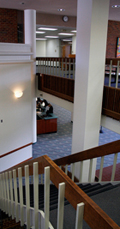 We’re in the process of planning a new library for George Mason University, adding if I remember correctly, roughly 150,000 square feet to our existing main library building. At present, it seems the ribbon cutting will occur sometime in 2014.
We’re in the process of planning a new library for George Mason University, adding if I remember correctly, roughly 150,000 square feet to our existing main library building. At present, it seems the ribbon cutting will occur sometime in 2014.
As part of our planning process, we’re all thinking about where Mason’s library should be in five years (opening day) and how the building plan we’re developing would cope with the subsequent thirty years. All pretty standard stuff in this context.
So everyone pretty much comes to the same conclusions, right?
Well, we’re all looking at the same information, living in the same present, and working within the same boundaries but there are definitely competing visions in a few areas. I’ve decided a lot depends on how you think about the future.
My approach begins with an acknowledgement of the volatility of technical expertise. Over the course of many years in library IT, I’ve seen that somewhere between 10 to 15 percent of what I know slips into obsolescence each year.
OK there was that year I got really good with OS/2 and the percentage went up for a bit but I’m talking averages…
If I’m predicting a future five years out, I assume half of what informs today’s speculation will be irrelevant by the time that future arrives. As a result, I just try to extend trend lines and pay much less attention to what’s actually occurring at this particular moment.
Another approach, and one I see many of my colleagues using, is to take what we’re doing now and base plans on predictions of how those activities might grow and evolve. It’s a reasonable approach–after all, there are rational reasons we do what we do today and it’s not too hard to envision how those activities might evolve over the next five years.
Pick your approach and you’ll likely come up with different answers to some of the questions a new building poses…particularly when it comes to technology.

For example, many of my colleagues want one area of the new library to house 100 desktop computers, each sporting a copy of Microsoft Office to boost researcher productivity. I appreciate the symbolic value of 100 but is that really what we want to have in place when the future arrives?
I think not although I’m in sympathy with anyone who wants to improve the technology in tomorrow’s library. My problem with carpetbombing an area of the new library with desktop PCs has a couple of dimensions:
- I don’t like the idea of librarians sending even the subliminal message that the best use of their skills and the facility is a computer lab. If you agree with me that librarians are becoming ever more marginalized, this sort of “quick fix” tactic to boost attendance could prove to be a long-term strategic disaster.
- The trend is toward mobility and the “cloud,” not anchored fleets of workstations. Our 2014 user (heck, let’s say our 2017 user since those machines would still be running) will likely still appreciate a fast network connection and plenty of places to recharge their personal productivity devices but I question how eager they’ll be to put away the device they’re using to manage their digital life (their work, their play and their communication) so they can sit down at a word processor on one of the 100 public workstations in this area of the library.
So, what happens going forward? Well, I have a strategy that I’ll follow as I try to bend the arc of this plan toward what I think will be a better outcome:
- I’m happy for now to fully support the idea of 100 work spaces (not workstations) and as we get closer to the sort of planning that accompanies actually building the space, I’ll argue that we set aside a portion of those spaces (large flat surface, electricity nearby, well-lit, gigabit access to Internet2, etc) for the mobile user. The proportion will fluctuate with a) the budget for the building (since these sorts of workplaces cost less than workstations) and b) how this “mobile/cloud thing” plays out over the next two-three years.
- I’ll argue that if we’re wrong about the number of workplaces we offer in relation to the number of workstations, we can always quickly add more equipment. However, if we favor too many workstations in the beginning, removing them will be both an embarrassment and admission of an expensive mistake.
- I’ll redouble my efforts to help librarians see that there are new services and technologies they might embrace to make the library a more “inviting” space for tomorrow’s researcher
- Oh, and I’ll recommend OpenOffice when the time’s right.
Let me know what you think.
